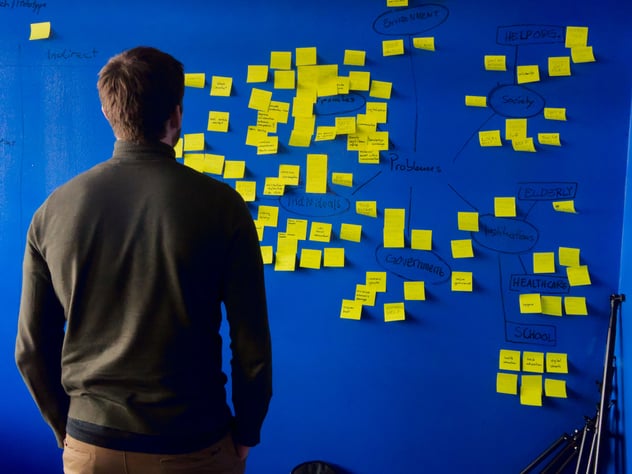What first comes to your mind when you think of brainstorming? Typically, it’s involved a group of people actively discussing innovative ideas, exchanging opinions, and arguing about controversial issues. However, things are changing. Because remote work is now increasingly the norm, more companies are organizing idea campaigns in the cloud, where participants are brainstorming and producing ideas on their own.
But how can you succeed in this usually team-based process and effectively brainstorm on your own? In this blog post, we explore the most effective methods of brainstorming to generate innovative ideas on your own.
What is brainstorming?
First things first, how do we define brainstorming?
There are many definitions of “brainstorming,” but in a nutshell, it’s a group creativity process designed to solve a problem or collect ideas without judging or evaluating them. The traditional process requires intensive discussion, with each team member suggesting as many ideas as possible.
The brainstorming technique was first devised in the 1930s by American advertising executive Alex Osborn, and was originally called “Think Up”. Almost 20 years later, in 1953, Osborn’s book “Applied Imagination” popularized the technique, which was quickly picked up by marketers and advertisers.
Why should you consider brainstorming by yourself?

Brainstorming is not strictly reserved for groups of people. Given the pace of today’s work environment, you’ve no doubt already tried brainstorming alone without even realizing it. And most likely, you’ve already experienced some of the many benefits of brainstorming, including:
-
Increased concentration
-
Routine-breaking
-
More efficient problem-solving
-
Time-saving
Surprisingly, individual brainstorming might be even more effective than a traditional group process, for a number of reasons:
-
Sometimes people are “blocked” by others’ ideas, so they become unable to generate their own ideas or they lose track of their ideas while listening to their team members.
-
Not all the team members strictly follow the rules of brainstorming and start judging or criticizing others. This behavior can lead to a tense atmosphere in the team and discourages creativity.
-
In solo brainstorming, you don’t need to worry about other team members’ opinions or emotions. So you’re more likely to consider controversial or seemingly imperfect ideas and explore them on your own.
To make your solo brainstorming process as productive as possible, we’ve listed below the most effective techniques for generating great ideas.
Solo brainstorming techniques for innovative idea generation
Zero draft
The “zero draft” technique is extremely popular among writers in particular and could help you come up with innovative ideas and problem-solving solutions. It s a great starting point for organizing your thoughts and finding the gaps in your knowledge that need to be filled.
The essence of this method is writing down your initial thoughts, ideas, emotions, and questions about a particular topic without trying to follow a structure or style. Don’t worry if it looks messy at first. Trust the process and let yourself express everything on paper.
Once you’ve written down your first thoughts, it can be helpful to organize them in a table or in an idea management software. For example, you could group ideas that you’re unsure about, questions that need to be answered, and ideas that you think have the most potential.
This method is a great starting point for developing and filtering your ideas.
SCAMPER
The SCAMPER technique encourages you to look at your idea or product from different angles to try to improve it. The main idea of the method is in the name itself, an acronym that inspires you to think outside the box:
- Substitute: Think about what can be replaced in your project. What would happen if you swapped resources?
- Combine: Consider what would happen if you combined your existing products or resources to create a new product. How would you feel about it?
- Adapt: Suppose you can change your product or idea to bring it to the next level. How should you do it? What steps should you take?
- Modify: How can you modify your product or idea? How should you change its appearance, values, and senses?
- Put to another use: Can this product be used another way? Should you target another audience?
- Eliminate or minimize: What aspects might make your idea or product too complex? Does it need to be simplified?
- Reverse: Consider reorganizing your idea and try looking at it “upside down”. Maybe it’s better this way?
Mind mapping
Mind mapping is one of the most structured and productive association techniques, enabling you to visually organize data and information. It’s a very popular technique, particularly for those who are better at interpreting data visually rather than in a list.
Organized around a central idea, a mind map works like the branches of a tree. Ideas and sub-ideas associated with the main idea branch off from the central idea. To get started with a mind map, write down the central question or problem and collect ideas in the form of bubbles around it.
A mind map is particularly effective for breaking down complex issues and gaining insights into all the elements related to them.
What if?
Do you ever feel that you’re so close to an idea but not quite there? “What if?” is a really useful brainstorming technique to help you formulate your ideas, and turn average ideas into excellent ones. It can help to eliminate “yeah but” negativity and discourages obstructing progress on an idea.
Simply asking “What if?” can turn everything on its head.
Many fiction writers advocate asking yourself “What if?” not only when you’re stuck, but even when your thought process is going well. Wondering what might happen if something changed, and using your brainstorming mind to run with it, is a clever way to view a project or problem differently.
Brainstorming on the move
Have you ever noticed that you often produce the most creative ideas in unlikely places, like the shower? That happens because your brain gets bored and tries to entertain itself by making you think!
So, why not take advantage of this brain feature and change the usual office environment for a short walk in a nearby park or a training session in the gym? Being in a different environment on your own with your ideas can often help you become more creative. Stepping away from your notes can help your brain make sense of the information and feed the solution back to you. But don’t forget to write down your freshly generated ideas!

Coming up with ideas on your own can sometimes be a challenge but try these brainstorming techniques and notice the difference they make the next time you’re researching problems and looking for solutions on your own. Have fun!










